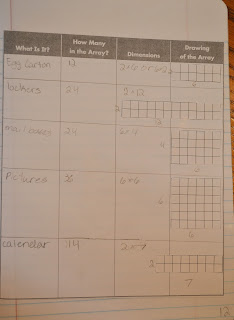 |
| Student Journal - Subtraction Strategies |
|
As a class, we discussed different subtraction strategies. The strategy most of our kids are familiar with (at least if they've been in the district a while) is the number line. If the problem were 634-319, they would start their number line at 319, and count on by taking "jumps" until they reached 634. Then they add up their jumps, and there's the difference. It's like subtraction without subtracting!! For those kiddos who struggle with subtraction, this strategy is perfect until they're more comfortable!
The second strategy we discussed is subtracting by place value. With subtraction (unlike adding by place value) it's very important to only break up one number by place value. Otherwise, you're looking at major confusion for most kids. If we were to solve 634-319 again, we would start with 634-300 = 334, then 334-10=324, then finally 324-9=315.
Of course one of our strategies is vertical subtraction, which is my absolute LEAST favorite way for kids to subtract - at least until they have a major grasp on place value! For me to allow a child to subtract vertically, he/she must explain to me step-by-step how to do it, all the while talking in terms of place value, not numbers. For example, 634-319 would be explained something like this:
"I cannot take 9 from 4, so I borrow a group of 10 from the 30 so it now becomes 20. The 4 now becomes a 14. 14 minus 9 is 5. 20 minus 10 is 10, but I only write the 1 because I'm working in the tens place. 600 minus 300 is 300, so my answer is 315."
I know that may not sound too difficult, but when the numbers get bigger and there's more borrowing involved, it's gets pretty confusing. If they can explain the process to me in a way that shows me they know what they're doing and
why they're doing it, they're free to do vertical subtraction all day long!
Our last strategy is shifting up/shifting down. I presented this strategy as a super-secret strategy that only they know. We even closed the blinds and door. Ha ha!! This strategy is for those kiddos who need the organization of the vertical strategy, but are still struggling with borrowing. We started by marking 8 and 16 on our number line and subtracting for a difference of 8. Then I added 1 to each number, making 9 and 17. Looking at our number line, we discovered it still had a difference of 8. Then I subtracted 3 from each number, making 5 and 13. Again, still a difference of 8. This led us into the discussion that if you change both numbers in the same way, you're not changing the difference between them. So we concluded that sometimes shifting the numbers up or down might help us in subtraction. For example, if I had the problem 2,002-412, I could shift both my numbers down 3, leaving me with 1,999-409. This is a much friendlier number to subtract! We did lots of examples using this strategy! Then we spent a little while coming up with reasons why this strategy wouldn't work the same for addition!! :)
 |
| Our Subtraction Strategies Anchor Chart |
 |
| Another Subtraction Strategy |



























































